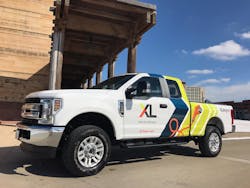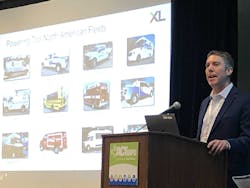XL reaches milestones, readies F-250 plug-in hybrid
As XL continues expanding into the plug-in hybrid market this year, it is also taking time to celebrate the accomplishments of its first decade in business.
The Boston-based company was founded in 2009 as XL Hybrids, and spent its initial years focusing on hybrid-electric technology for Classes 2-6 commercial and municipal vehicles in partnership with vehicle manufacturers including Ford, Chevrolet, General Motors and Isuzu.
During the summer, it crossed the 100 million mile mark and topped 2 million total gallons of fuel saved. Eric Foellmer, XL’s director of marketing, called these milestones “significant accomplishments,” especially considering how “many companies have come and gone” in the hybrid and electrification space during the past decade.
Foellmer spoke with Fleet Owner in late August as XL was taking orders for the plug-in hybrid electric Ford Super Duty F-250 pickup truck first shown at the Work Truck Show earlier this year. Deliveries of the XLP F-250 is expected to start at the end of the year, reflecting another step in the company’s roadmap to eventually offer all-electric versions.
The F-250 will join the XLP F-150 that XL began shipping in 2018 to municipal, utility and commercial fleets. “These are the only two plug-in hybrid F-series trucks on road today,” Foellmer said.
The XLP F-250 is projected to provide up to a 50% improvement in miles driven per gallon over conventional units, while reducing greenhouse gas emissions by 33% during normal operation, similar to what the PHEV F-150 has achieved during testing.
It features a high voltage 15 kWh lithium-ion battery pack that can use charging stations, but is also charged by regenerative braking during driving, which captures and stores energy while slowing the vehicle. The energy is then transferred back into the drivetrain through an electric motor. The entire system weighs 750 pounds and is mounted onto existing factory components.
Foellmer said the battery electric market is still “dependent on incentives to justify [vehicle] purchases” due to the cost of batteries and infrastructure challenges.
Conversely, XL had worked methodically to make its systems “economically viable without incentives.” Its technology also means that fleets can begin investing in electric vehicles while not having concerns about electric batteries running out in the middle of a trip.
One of XL’s first customers, Coca-Cola, has deployed nearly 300 hybrid electric GMC Chevy Express vans to its fleet since 2012. XL recently examined the data from the first 10 vehicles deployed in 2012-13. The vehicles are still on the road and have driven an average of 150,000 miles each.
About the Author
Neil Abt
Neil Abt is a former FleetOwner editor who wrote for the publication from 2017 to 2020. He was editorial director from 2018 to 2020.

